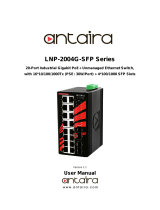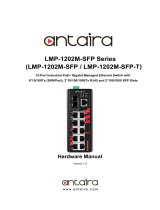TP-LINK tp-link Unmanaged Desktop PoE Switch Installation guide
- Category
- Network switches
- Type
- Installation guide
This manual is also suitable for

Installation Guide
Connection
Unmanaged Desktop PoE Switch
PC
IP Camera AP
Ethernet Ports (1-8)
PoE Ports (1-4)
IP Phone
PoE Devices
TL-SL1210MP has two uplink ports, which typically connect to uplink devices like routers.
Uplink 1 is an SFP port and works with a 1000 Mbps SFP module. Uplink 2 is an RJ45 port.
PoE ports can also connect to non-PoE devices, but only transmit data.
TL-SF1008LP can supply up to 15.4 W for each PoE port and 41 W for all PoE ports.
TL-SF1008P can supply up to 30 W for each PoE port and 66 W for all PoE ports.
TL-SF1009P can supply up to 30 W for each PoE port and 65 W for all PoE ports.
TL-SL1210MP can supply up to 30 W for each PoE port and 124 W for all PoE ports.
Note:
1.
2.
3
.
Internet
Link/Act
Link/Act
Port 1–8/Port 1–9 (for TL-SF1009P)/
Uplink 1, Uplink2 (for TL-SL1210MP)
On: Link present but no activity
Flashing: Transmitting/receiving data
O: No link
PoE Status
PoE Status
Port 1–4 (for TL-SF1008LP/TL-SF1008P)/
Port 1–8 (for TL-SF1009P/TL-SL1210MP)
On: PoE power provided
Flashing: Current-overload/ Short-circuit
O: No PoE power provided
Power
Power
On: Power on
O: Power o
© 2020 TP-Link 7106508808 REV6.1.0
LED Explanation
DC Power Adapter
AC Power Cord
Switches Explanation
Note: For simplicity, we will take TL-SF1008P for example throughout the Guide.
O: Port 1–4 run at 10/100 Mbps and support PoE power supply up to 100 m away.
On: Port 1–4 run at 10 Mbps and support PoE power supply up to 250 m away.
Extend (1–4) (for TL-SF1008LP/TL-SF1008P)
PoE MAX
PoE MAX
TL-SF1008LP
On: 34 W ≤ Total power supply < 41 W
Flashing: Total power supply = 41 W
O: Total power supply < 34 W
TL-SF1008P
On: 59 W ≤ Total power supply < 66 W
Flashing: Total power supply = 66 W
O: Total power supply < 59 W
TL-SF1009P
On: 58 W ≤ Total power supply < 65 W
Flashing: Total power supply = 65 W
O: Total power supply < 58 W
TL-SL1210MP
On: 117 W ≤ Total power supply < 124 W
Flashing: Total power supply = 124 W
O: Total power supply < 117 W
O: Port 1–8 run at 10/100 Mbps and support PoE power supply up to 100 m away.
On (1-4): Port 1–4 run at 10 Mbps and support PoE power supply up to 250 m away.
On (1-8): Port 1–8 run at 10 Mbps and support PoE power supply up to 250 m away.
Extend (for TL-SF1009P and TL-SL1210MP)
O: Port 1–8 can transmit data with every port.
On (1-8): Port 1–8 cannot transmit data with each other. They can transmit data only with the
uplink port.
Isolation (for TL-SF1009P and TL-SL1210MP)
O
: All the ports transmit data with the same priority.
On/On (1-2): Port 1–2 transmit data with a higher priority than other ports.
Priority (1–2)/Priority (except TL-SL1210MP)

Frequently Asked Questions (FAQ)
The Power LED should be lit when the power system is working normally. If the Power LED is
not lit, please check as follows:
A1:
Make sure the AC power cord is connected the switch with power source properly.
A2:
Make sure the voltage of the power supply meets the requirements of the input voltage
of the switch.
A3:
Make sure the power source is on.
Q1. The Power LED is not lit.
It is recommended that you check the following items:
A1:
Make sure that the cable connectors are rmly plugged into the switch and the device.
A2:
Make sure the connected device is turned on and working well.
A3:
The cable must be less than 100 meters long (328 feet). If Extend Mode is enabled, it
should be less than 250 meters (820 feet).
Q2. The Link/Act LED is not lit when a device is connected to the
corresponding port.
When the total power consumption of connected PoE devices exceeds the maximum, the
PoE port with a smaller port number has a higher priority. The system will cut o power to
the ports with larger port numbers to ensure supplying to other ports.
Take TL-SF1008P as an example. If port 1, 2 and 4 are consuming 15.4 W respectively, and
an additional PoE device with 20 W is inserted to port 3, the system will cut o the power of
port 4 to compensate for the overload.
Q3. Why are PoE ports not supplying power for PoE devices?
For technical support and other information, please visit
https://www.tp-link.com/support, or simply scan the QR code.
If you have any suggestions or needs on the product guides, welcome
to email tech[email protected]om.cn.
To ask questions, find answers, and communicate with TP-Link users or
engineers, please visit https://communit y.tp-link.com to join TP-Link
Community.
Safety Information
Keep the device away from water, re, humidity or hot environments.
Do not attempt to disassemble, repair, or modify the device. If you need service, please
contact us.
Do not use damaged charger or USB cable to charge the device.
Do not use any other chargers than those recommended.
Adapter shall be installed near the equipment and shall be easily accessible.
Place the device with its bottom surface downward.
TP-Link hereby declares that the device is in compliance with the essential requirements and
other relevant provisions of directives 2014/30/EU, 2014/35/EU, 2009/125/EC, 2011/65/EU
and (EU)2015/863.
The original EU declaration of conformity may be found at https://www.tp-link.com/en/ce.
EU Declaration of Conformity
PoE Disclaimer
The speed of the ports in extend mode will downgrade to 10 Mbps. The actual transmission
distance may vary due to power consumption of PoE-powered devices or the cable quality
and type.
PoE budget calculations are based on laboratory testing. Actual PoE power budget is not
guaranteed and will vary as a result of client limitations and environmental factors.
General Specications
Specications
IEEE 802.3i, IEEE 802.3u, IEEE 802.3x, IEEE 802.3af,
IEEE802.3at (Except TL-SF1008LP)
IEEE 802.3ab (Only for TL-SL1210MP)
IEEE 802.3z (Only for TL-SL1210MP)
CSMA/CD
TL-SF1008LP/TL-SF1008P:
8 10/100 Mbps RJ45 Ports
Auto-Negotiation/Auto MDI/MDIX
PoE Ports: Port 1–4
TL-SF1009P:
9 10/100 Mbps RJ45 Ports
Auto-Negotiation/Auto MDI/MDIX
PoE Ports: Port 1–8
TL-SL1210MP:
8 10/100 Mbps RJ45 Ports
Auto-Negotiation/Auto MDI/MDIX
1 10/100/1000 Mbps RJ45 Port
1 1000 Mpbs SFP Port
PoE Ports: Port 1–8
10BASE-T:
UTP category 3, 4, 5 cable (maximum 100 m)
EIA/TIA-568 100
Ω
STP (maximum 100 m)
100BASE-TX:
UTP category 5, 5e cable (maximum 100 m)
EIA/TIA-568 100
Ω
STP (maximum 100 m)
1000BASE-T (Only for TL-SL1210MP):
UPT category 5e cable or above (maximum 100m)
EIA/TIA-568 100
Ω
STP (maximum 100 m)
1000BASE-SX/LX/LX10/BX10 (Only for TL-SL1210MP):
MMF, SMF
TL-SF1008LP/TL-SF1008P: 1.6 Gbps
TL-SF1009P: 1.8 Gbps
TL-SL1210MP: 5.6 Gbps
2K
Store-and-Forward
Automatically learning, automatically aging
External Power Adapter
Input: 100-240 VAC, 50/60 Hz
Output:
TL-SF1008LP: 53.5 VDC/0.81 A
TL-SF1008P/TL-SF1009P: 53.5 VDC/1.31 A
TL-SL1210MP: 53.5 VDC/2.43 A
Ye s
TL-SF1008LP/TL-SF1008P/TL-SF1009P: 105 mm
TL-SL1210MP: 150 mm
Standard
Wall Mountable
Distance Between
Mounting Holes
Network Media (Cable)
MAC Address Table
Interface
Switching Capacity
Protocol
Power Supply
Environmental and Physical Specications
FCC, CE, RoHS
0˚C to 40˚C (32˚F to 104˚F)
-40˚C to 70˚C (-40˚F to 158˚F)
10% to 90% non-condensing
5% to 90% non-condensing
Certication
Transfer Method
MAC Address Learning
Operating Temperature
Storage Temperature
Operating Humidity
Storage Humidity
-
 1
1
-
 2
2
TP-LINK tp-link Unmanaged Desktop PoE Switch Installation guide
- Category
- Network switches
- Type
- Installation guide
- This manual is also suitable for
Ask a question and I''ll find the answer in the document
Finding information in a document is now easier with AI
in other languages
Related papers
-
TP-LINK UH400 Quick Installation Guide
-
TP-LINK UH720 Quick Installation Guide
-
TP-LINK TL-SF1009P User guide
-
TP-LINK TL-SG105PP-M2 Installation guide
-
TP-LINK tp-link TL-SG105PP-M2 5-Port 2.5G Desktop Switch Installation guide
-
TP-LINK TL-SF1008D User manual
-
TP-LINK TL-POE160S Installation guide
-
TP-LINK TL-SF1008P Installation guide
-
TP-LINK TL-WR1043ND User manual
-
TP-LINK TL-SG108S Owner's manual
Other documents
-
Tenda TEF1118P-16-150W Installation guide
-
Foundry Networks FWSX448 Installation guide
-
Allen-Bradley Stratix 8300 User manual
-
Tenda TEF1126P-24-250W Installation guide
-
Allen-Bradley Stratix 8300 User manual
-
Interlogix IFS MC252-4P-1S User manual
-
 ANTAIRA LNP-2004G-SFP Series User manual
ANTAIRA LNP-2004G-SFP Series User manual
-
 Moxa Technologies EDS-G205A Series Quick Install Guide
Moxa Technologies EDS-G205A Series Quick Install Guide
-
Intellinet 24-Port Gigabit Ethernet PoE Web-Managed AV Switch with 2 SFP & 2 SFP/RJ45 Combo Uplinks User manual
-
 ANTAIRA LMP-1202M-SFP-T User manual
ANTAIRA LMP-1202M-SFP-T User manual




